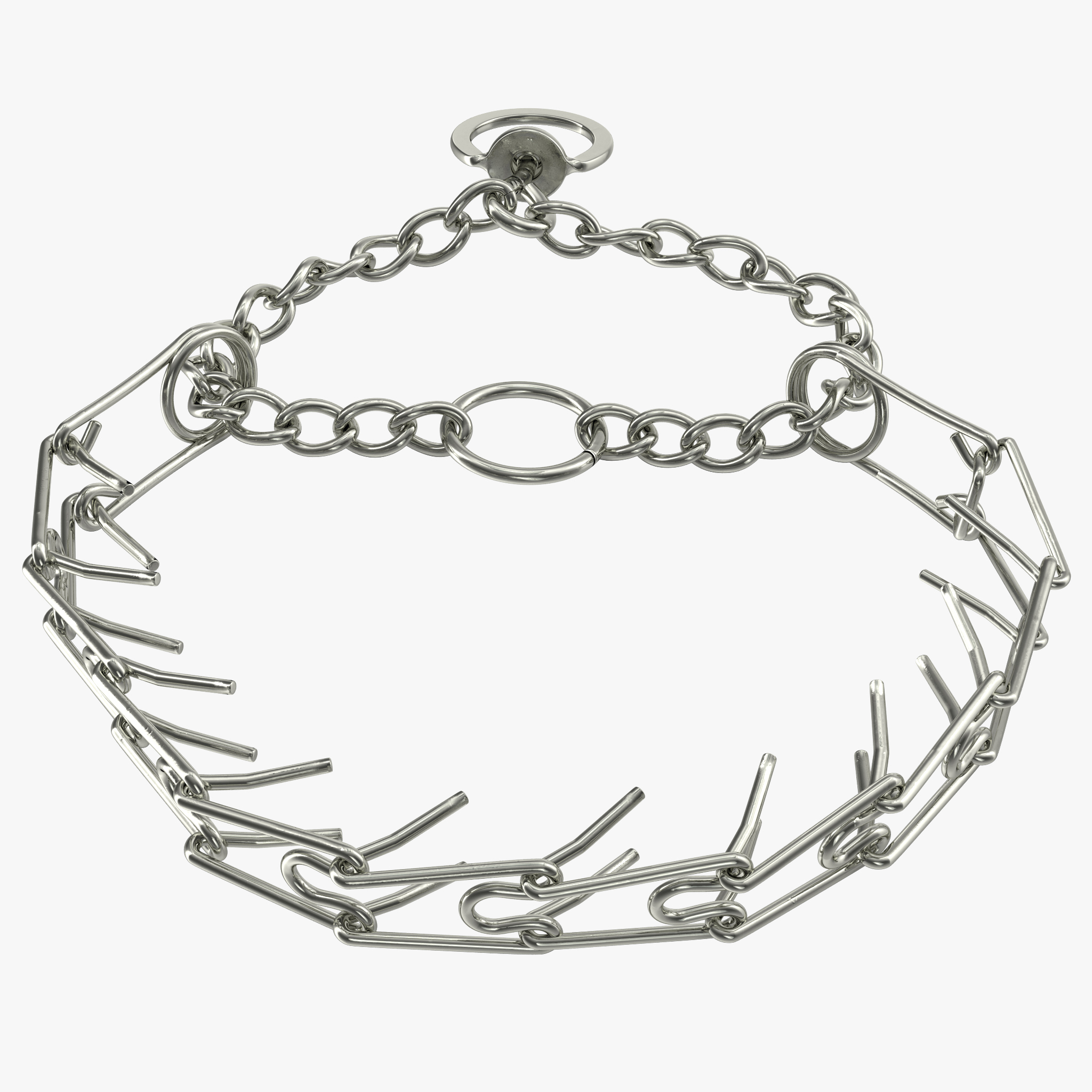Pronged collars (also known as a pinch or constriction collar) are illegal to import into Australia but are only illegal to use on dogs in Victoria, Tasmania and Queensland. The RSPCA is opposed to the import, sale, or use of equipment used to modify the behaviour of a companion animal which are inhumane, cause injury, pain, suffering, or distress to the animal, or can be used to abuse animals, including pronged or pinch collars. There are other more humane training methods available.
What is a pronged collar?
Pronged collars have a series of fang-shaped metal links, or prongs, with blunted points which pinch the loose skin on a dog’s neck when pulled. Pronged collars work by inflicting pain as punishment in an attempt to correct unwanted behaviour. These collars are used as part of aversive training.

Risks and harms related to aversive training
Aversive training techniques and tools (including but not limited to pronged collars) cause animals physical discomfort, pain, potential injury, stress, fear, anxiety, and other negative emotional states, thereby compromising animals’ mental and physical welfare [1–3].
There is extensive evidence supporting the association between the use of aversive training methods and short-term indicators of stress and welfare compromise, long-term behaviour problems including anxiety-related and aggressive behaviours, and poor learning [1–7]. For example, a UK study found that punishment-based methods used by owners increased the risk of dogs showing aggression to family members and unfamiliar people[8]. A study of military handlers showed that dogs who were trained using punishment-based methods, including the use of pronged and shock collars, were less obedient, tended to bite more, and showed problem behaviours and poor welfare [9]. The reduction in learning ability associated with punishment based methods was shown in a study which demonstrated that dogs who were trained using reward based methods were better at learning a new task compared to dogs who were trained using punishment [4].
There is now a large body of evidence supporting the use of reward-based training as an effective and humane way of training dogs that is associated with fewer welfare and behaviour concerns than the use of aversive methods.
Risks and harms specifically related to pronged collars In addition to the general welfare risks and harms associated with aversive training techniques, there are specific welfare risks and harms that have been reported related to pronged collars, including the following: stress [10]; aggression [11]; lower owner satisfaction with their dogs’ overall behaviour and leash walking behaviour [12]; and physical harm (acute blindness, severe swelling of the head, and inability to close the jaw, trauma and abrasions to the neck, serious puncture wounds, nerve damage, muscle injury, and laryngeal, oesophageal, thyroidal, and tracheal damage) [13–16].
What can be done?
Many dog trainers and animal welfare groups continue to advocate for the sale and use of pronged collars to be prohibited in all jurisdictions. Dog owners who seek trainers who use reward-based methods can be confident that their dog will not be subjected to a pronged collar.
References
[1] Ziv G (2017) The effects of using aversive training methods in dogs—A review. Journal of Veterinary Behavior: Clinical Applications and Research 19:50–60
[2] Casey RA, Naj-Oleari M, Campbell S, Mendl M, Blackwell EJ (2021) Dogs are more pessimistic if their owners use two or more aversive training methods. Sci Rep. https://doi.org/10.1038/s41598-021-97743-0
[3] Makowska I (2018) Review of dog training methods: welfare, learning ability, and current standards. Vancouver
[4] Rooney NJ, Cowan S (2011) Training methods and owner-dog interactions: Links with dog behaviour and learning ability. Appl Anim Behav Sci 132:169–177
[5] Overall KL (2007) Considerations for shock and “training” collars: Concerns from and for the working dog community. Journal of Veterinary Behavior: Clinical Applications and Research 2:103–107
[6] Guilherme Fernandes J, Olsson IAS, Vieira de Castro AC (2017) Do aversive-based training methods actually compromise dog welfare?: A literature review. Appl Anim Behav Sci 196:1–12
[7] de Castro ACV, Fuchs D, Morello GM, Pastur S, de Sousa L, Olsson IAS (2020) Does training method matter? Evidence for the negative impact of aversive-based methods on companion dog welfare. PLoS One. https://doi.org/10.1371/journal.pone.0225023
[8] Blackwell EJ, Twells C, Seawright A, Casey RA (2008) The relationship between training methods and the occurrence of behavior problems, as reported by owners, in a population of domestic dogs. Journal of Veterinary Behavior: Clinical Applications and Research 3:207–217
[9] Lefebvre D, Diederich C, Delcourt M, Giffroy JM (2007) The quality of the relation between handler and military dogs influences efficiency and welfare of dogs. Appl Anim Behav Sci 104:49–60
[10] Salgirli Y, SchalkeI E, Boehm I, Hackbarth H (2012) Comparison of learning effects and stress between 3 different training methods (electronic training collar, pinch collar and quitting signal) in Belgian Malinois police dogs. Revue de Médecine Vétérinaire 163:530–535
[11] Herron ME, Shofer FS, Reisner IR (2009) Survey of the use and outcome of confrontational and non-confrontational training methods in client-owned dogs showing undesired behaviors. Appl Anim Behav Sci 117:47–54
[12] Kwan JY, Bain MJ (2013) Owner Attachment and Problem Behaviors Related to Relinquishment and Training Techniques of Dogs. Journal of Applied Animal Welfare Science 16:168–183
[13] Brida AL, O’ Toole TE, Sutherland-Smith J, Pirie C, Kowaleski MP (2019) Compartment syndrome of the muscles of mastication in a working dog following a traumatic training incident. Journal of Veterinary Emergency and Critical Care 29:321–325
[14] Brammeier S, Brennan J, Brown S, et al (2006) Good trainers: How to identify one and why this is important to your practice of veterinary medicine. Journal of Veterinary Behavior: Clinical Applications and Research 1:47–52
[15] Horwitz DF, Pike AL (2014) Common sense behavior modification: A guide for practitioners. Veterinary Clinics of North America – Small Animal Practice 44:401–426
[16] Cobb M, Branson N, McGreevy P, Lill A, Bennett P (2015) The advent of canine performance science: Offering a sustainable future for working dogs. Behavioural Processes 110:96–104
